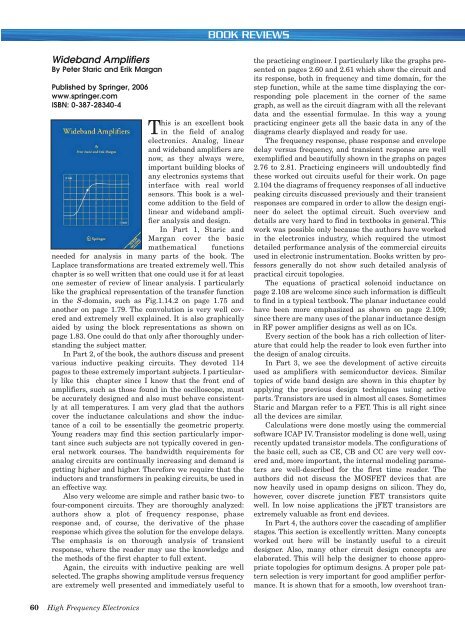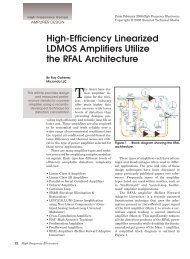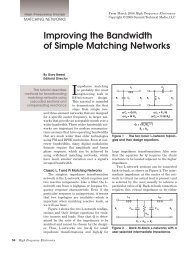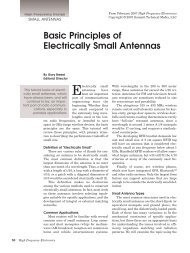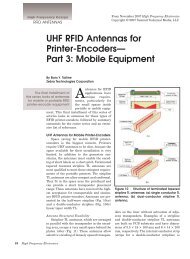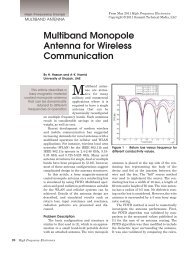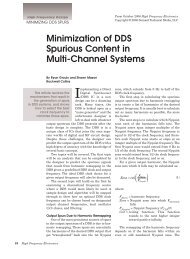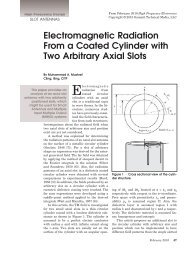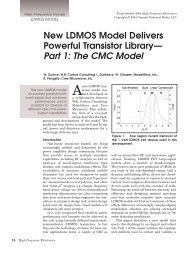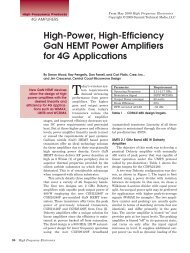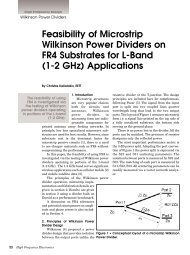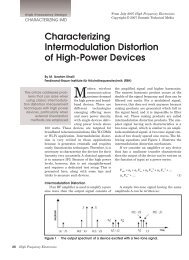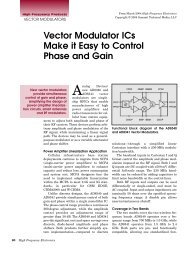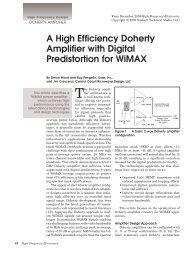Wideband Amplifiers - High Frequency Electronics
Wideband Amplifiers - High Frequency Electronics
Wideband Amplifiers - High Frequency Electronics
Create successful ePaper yourself
Turn your PDF publications into a flip-book with our unique Google optimized e-Paper software.
BOOK REVIEWS<br />
<strong>Wideband</strong> <strong>Amplifiers</strong><br />
By Peter Staric and Erik Margan<br />
Published by Springer, 2006<br />
www.springer.com<br />
ISBN: 0-387-28340-4<br />
This is an excellent book<br />
in the field of analog<br />
electronics. Analog, linear<br />
and wideband amplifiers are<br />
now, as they always were,<br />
important building blocks of<br />
any electronics systems that<br />
interface with real world<br />
sensors. This book is a welcome<br />
addition to the field of<br />
linear and wideband amplifier<br />
analysis and design.<br />
In Part 1, Staric and<br />
Margan cover the basic<br />
mathematical functions<br />
needed for analysis in many parts of the book. The<br />
Laplace transformations are treated extremely well. This<br />
chapter is so well written that one could use it for at least<br />
one semester of review of linear analysis. I particularly<br />
like the graphical representation of the transfer function<br />
in the S-domain, such as Fig.1.14.2 on page 1.75 and<br />
another on page 1.79. The convolution is very well covered<br />
and extremely well explained. It is also graphically<br />
aided by using the block representations as shown on<br />
page 1.83. One could do that only after thoroughly understanding<br />
the subject matter.<br />
In Part 2, of the book, the authors discuss and present<br />
various inductive peaking circuits. They devoted 114<br />
pages to these extremely important subjects. I particularly<br />
like this chapter since I know that the front end of<br />
amplifiers, such as those found in the oscilloscope, must<br />
be accurately designed and also must behave consistently<br />
at all temperatures. I am very glad that the authors<br />
cover the inductance calculations and show the inductance<br />
of a coil to be essentially the geometric property.<br />
Young readers may find this section particularly important<br />
since such subjects are not typically covered in general<br />
network courses. The bandwidth requirements for<br />
analog circuits are continually increasing and demand is<br />
getting higher and higher. Therefore we require that the<br />
inductors and transformers in peaking circuits, be used in<br />
an effective way.<br />
Also very welcome are simple and rather basic two- to<br />
four-component circuits. They are thoroughly analyzed:<br />
authors show a plot of frequency response, phase<br />
response and, of course, the derivative of the phase<br />
response which gives the solution for the envelope delays.<br />
The emphasis is on thorough analysis of transient<br />
response, where the reader may use the knowledge and<br />
the methods of the first chapter to full extent.<br />
Again, the circuits with inductive peaking are well<br />
selected. The graphs showing amplitude versus frequency<br />
are extremely well presented and immediately useful to<br />
the practicing engineer. I particularly like the graphs presented<br />
on pages 2.60 and 2.61 which show the circuit and<br />
its response, both in frequency and time domain, for the<br />
step function, while at the same time displaying the corresponding<br />
pole placement in the corner of the same<br />
graph, as well as the circuit diagram with all the relevant<br />
data and the essential formulae. In this way a young<br />
practicing engineer gets all the basic data in any of the<br />
diagrams clearly displayed and ready for use.<br />
The frequency response, phase response and envelope<br />
delay versus frequency, and transient response are well<br />
exemplified and beautifully shown in the graphs on pages<br />
2.76 to 2.81. Practicing engineers will undoubtedly find<br />
these worked out circuits useful for their work. On page<br />
2.104 the diagrams of frequency responses of all inductive<br />
peaking circuits discussed previously and their transient<br />
responses are compared in order to allow the design engineer<br />
do select the optimal circuit. Such overview and<br />
details are very hard to find in textbooks in general. This<br />
work was possible only because the authors have worked<br />
in the electronics industry, which required the utmost<br />
detailed performance analysis of the commercial circuits<br />
used in electronic instrumentation. Books written by professors<br />
generally do not show such detailed analysis of<br />
practical circuit topologies.<br />
The equations of practical solenoid inductance on<br />
page 2.108 are welcome since such information is difficult<br />
to find in a typical textbook. The planar inductance could<br />
have been more emphasized as shown on page 2.109;<br />
since there are many uses of the planar inductance design<br />
in RF power amplifier designs as well as on ICs.<br />
Every section of the book has a rich collection of literature<br />
that could help the reader to look even further into<br />
the design of analog circuits.<br />
In Part 3, we see the development of active circuits<br />
used as amplifiers with semiconductor devices. Similar<br />
topics of wide band design are shown in this chapter by<br />
applying the previous design techniques using active<br />
parts. Transistors are used in almost all cases. Sometimes<br />
Staric and Margan refer to a FET. This is all right since<br />
all the devices are similar.<br />
Calculations were done mostly using the commercial<br />
software ICAP IV. Transistor modeling is done well, using<br />
recently updated transistor models. The configurations of<br />
the basic cell, such as CE, CB and CC are very well covered<br />
and, more important, the internal modeling parameters<br />
are well-described for the first time reader. The<br />
authors did not discuss the MOSFET devices that are<br />
now heavily used in opamp designs on silicon. They do,<br />
however, cover discrete junction FET transistors quite<br />
well. In low noise applications the jFET transistors are<br />
extremely valuable as front end devices.<br />
In Part 4, the authors cover the cascading of amplifier<br />
stages. This section is excellently written. Many concepts<br />
worked out here will be instantly useful to a circuit<br />
designer. Also, many other circuit design concepts are<br />
elaborated. This will help the designer to choose appropriate<br />
topologies for optimum designs. A proper pole pattern<br />
selection is very important for good amplifier performance.<br />
It is shown that for a smooth, low overshoot tran-<br />
60 <strong>High</strong> <strong>Frequency</strong> <strong>Electronics</strong>
sient response of the envelope delay the pole pattern is<br />
followed by the use Bessel functions. It is also shown how<br />
important is to choose the staggered poles in multistage<br />
amplifiers instead of repeated poles, particularly when<br />
the gain × bandwidth efficiency is of utmost concern.<br />
In Part 5, the system synthesis and the integration of<br />
components is discussed. This is a well-written self-standing<br />
chapter with good graphics.<br />
In Part 6 are presented the computer algorithms for<br />
analysis and synthesis of amplifier/filters and systems.<br />
In Part 7 are given algorithms and application examples.<br />
The authors are using well known software by<br />
MatLab. A compact disc is included with the book; examples<br />
are worked out in the software.<br />
This book is definitely the best work I have seen in<br />
this particular category. The book is excellent for practicing<br />
engineers, and could also be used as a textbook in post<br />
graduate electrical engineering courses. The professor<br />
who uses it as a text will have to assign his own homework<br />
problems since the book does not include them.<br />
Design of circuits in wireless world, communications,<br />
and the analog design on silicon has become much richer<br />
with the publication of this book. I strongly recommend<br />
that every electronics designer have this book in his or<br />
her personal library.<br />
Reviewed by Anton Mavretic, Ph.D.<br />
Center for Space Physics<br />
Boston University<br />
E-mail: mavretic@bu.edu<br />
Classic Works in RF Engineering<br />
Combiners, Couplers, Transformers and<br />
Magnetic Materials<br />
By John L.B. Walker, Daniel P. Myer,<br />
Frederick H. Raab and Chris Trask<br />
Published by Artech House, 2006<br />
www.artechhouse.com<br />
ISBN: 1-58053-056-7<br />
How often do you wish it<br />
was easier to find a classic<br />
reference, particularly a<br />
technical paper that may be<br />
more than 40 years old? This<br />
problem is especially frustrating<br />
for topics that are not<br />
well-covered in textbooks,<br />
where the collected papers<br />
on the subject are the primary<br />
source of background<br />
information. Here is a book<br />
that solves this problem for<br />
one specific topic—RF transformers, particularly those<br />
using ferrite and powdered-iron magnetic materials, typically<br />
used from low frequencies to UHF.<br />
Fifty-three classic papers are reprinted in this book,<br />
grouped by subtopic. Each chapter includes substantial<br />
introductory material by the authors, followed by the<br />
reprints of pertinent papers. I should note that these<br />
introductions include a list of references beyond those<br />
that are reprinted. The six chapters are:<br />
Chapter 1: Introduction<br />
Chapter 2: Magnetic Materials<br />
This chapter collects hard-to-find data on the characteristics<br />
of ferrite and iron powder magnetic cores, including<br />
composition, permeability, losses, temperature variations<br />
and other parameters. Most of the references are<br />
not well known, except to specialists in this area.<br />
Chapter 3: Baluns/Hybrids/Anti-Phase Power Splitters<br />
Antennas and push-pull amplifiers are good examples<br />
where conversion of a signal between unbalanced<br />
(ground-referenced) and balanced (ground-independent)<br />
sources and loads is required. L-C, transmission line and<br />
transformer-based designs are among the types considered.<br />
Chapter 4: Transmission Line Transformers<br />
This chapter covers broadband impedance matching<br />
using transmission line transformers. In particular, this<br />
chapter addresses topologies, design methods and construction<br />
techniques required to obtain a transformer<br />
with the desired impedance transformation ratio, bandwidth,<br />
loss and power handling capabilities.<br />
Chapter 5: Hybrid Power Combiners and Splitters<br />
The principles of transmission line transformers are<br />
extended to power combining/dividing circuits in this<br />
chapter. The emphasis is on high-power applications,<br />
although the circuits are certainly scalable for small-signal<br />
implementation.<br />
Chapter 6: Quadrature Combiners and Splitters<br />
This more specialized circuit is difficult to implement<br />
in wide bandwidths, but its value in areas such as oddorder<br />
harmonic cancellation in combined power amplifier<br />
systems makes it an interesting topic for many designers.<br />
Some of the reprinted papers are widely-referenced<br />
seminal papers by such authors as Guanella, Ruthroff,<br />
Wilkinson, Pitzalis and Granberg. Others are papers and<br />
journal articles by a variety of authors, many of whom<br />
addressed one specific aspect of the subject. Some of these<br />
papers may be the only published material on their<br />
respective topics.<br />
The subject of this book is one of personal interest,<br />
and I have used many of these circuits in radio and<br />
antenna systems over the past 30 years. I am also gratified<br />
to see that eleven of the papers selected by the<br />
authors were originally published under my direction in<br />
technical magazines and at engineering conferences.<br />
Reviewed by Gary Breed<br />
Editorial Director<br />
<strong>High</strong> <strong>Frequency</strong> <strong>Electronics</strong><br />
From October 2006 <strong>High</strong> <strong>Frequency</strong> <strong>Electronics</strong><br />
Copyright © 2006 Summit Technical Media, LLC<br />
October 2006 61


